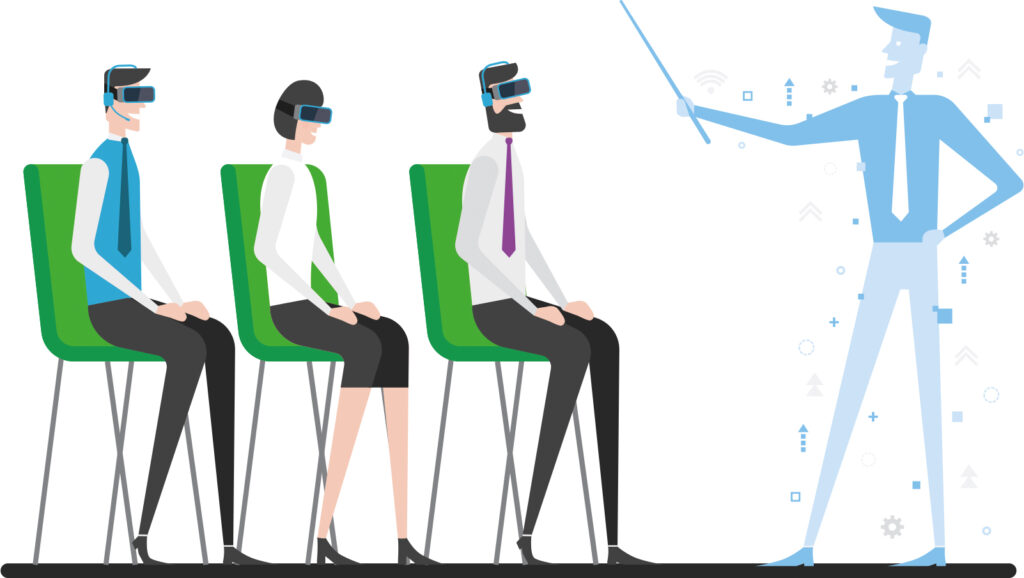Though the dream of immersive experiences has been around for decades, with early concepts like the 1962 Sensorama, limitations in processing power and accessibility kept them out of reach. Now, with significant advancements in what engineers and developers can create, virtual reality (VR) and augmented reality (AR) are benefitting many industries. New headsets from Apple and Meta along with the rise of markerless AR—tech that doesn’t require pre-defined markers or codes to work—are opening doors for widespread integration.
This year, the global market is projected to reach over $32 billion, and climb to over $244 billion by 2032.1 This rapid growth is fueled by businesses embracing these technologies to enhance customer experiences, streamline operations, boost training opportunities, and open new revenue streams.
A New Era of Immersive Training
VR allows companies to create immersive training simulations for soft skills including public speaking and active listening. Platforms, such as VirtualSpeech, offer training that blends e-learning with VR simulations, giving employees a safe, risk-free space to learn. VR training offers several advantages:
- It’s consistent, ensuring everyone receives the same quality training.
- It’s affordable, eliminating travel and venue costs for in-person engagements.
- It’s highly scalable, making it suitable for large, geographically dispersed organizations.
Beyond the Classroom: VR in Education
The education sector is also capitalizing on VR’s potential. Educational tech companies, such as Nearpod, use VR to create field trips, transporting students virtually to different parts of the world. Imagine a history lesson where students walk the Great Wall of China or explore the ruins of ancient Rome! VR is also used for experiential learning in space exploration and historical reenactments, making education more engaging and interactive.
Remote Collaboration: Boosting Efficiency and Expertise
AR shines in overlaying digital information onto the real world. Modern headsets make remote collaboration and complex manufacturing processes more straightforward and clearer. With AR, workers can overlay instructions directly onto machinery, showing precisely what needs to be done and how, reducing errors and training time. AR can also be used to virtually inspect products for flaws before they’re built, preventing wasted materials and time spent fixing mistakes later.
Enhancing Experiences: Live Events
The sports industry is a prime example of how VR is being used to enhance customer experiences. The NBA and UEFA Champions League finals have been broadcast in VR, allowing viewers to experience the games virtually from various viewpoints within the stadium. In 2022, the band Foo Fighters played a concert on the Meta stage, providing an immersive experience via the Meta headset available worldwide.
Retail Gets a Virtual Makeover
Retailers are also leveraging the power of VR to transform the shopping experience. Virtually trying on clothes, glasses, or even a new haircut or color before you buy is today’s norm. VR allows customers to personalize their shopping experience from the comfort of their homes, reducing the need for in-store visits and enabling more informed purchasing decisions.
Every Industry Benefits: From Design to Automotive to Healthcare
The applications of VR and AR extend far beyond the examples listed above. The automotive industry is using VR for product design and manufacturing processes. Companies such as Ford and Hyundai employ VR in global vehicle design reviews. This not only saves time and resources but also fosters worldwide collaboration.
In healthcare, AR applications such as MedicAR and MEVIS Surgery assist in medical procedures and patient interactions. These technologies provide valuable support for surgeons during complex operations and offer a more interactive learning experience for medical students.
A Blueprint for Leadership
With new technology comes new ideas for services that can put a company ahead.
- Forge new competitive advantages. Business leaders have a unique opportunity to harness AR and VR. Leaders can identify clear use cases that align with the company’s strategic goals. Investing in pilot projects can help determine the technology’s potential impact and ROI before a full-scale rollout.
- Build the culture. Thoughtful training and development equip teams with the necessary skills to ensure smooth adoption and integration. Leaders should foster a culture of innovation, where experimentation is encouraged and failures are seen as learning opportunities.
- Lean on trusted partners. Collaboration with technology partners and industry experts can provide valuable insights and support and help businesses navigate challenges.
By taking these steps, leaders can adapt to the evolving technological landscape and shape it to fit their organizational needs, ensuring that AR and VR are not just futuristic concepts but integral tools driving business success.
- Fortune Business Insights, Virtual Reality (VR) Market Size, Share & Industry Analysis, Apr 2024
